Introduction
After a court decision that made the 1934 Presidential decree made by Mustafa Kemal Atatürk void, Turkish President Recep Tayyip Erdoğan announced that Istanbul’s famous and historical sanctuary and museum Ayasofya (Hagia Sophia)[1] will be used as a public mosque starting from July 24, 2020. Shortly after Turkey’s Council of State (Danıştay) announced its long-awaited decision in favor of the possible status change, President Erdoğan immediately issued a decree and ordered the transfer of the management of the historic site from the Ministry of Culture to the Directorate of Religious Affairs (Diyanet İşleri Başkanlığı), paving the way for its conversion.[2]
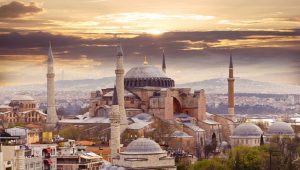
Hagia Sophia
Hagia Sophia
Built between 532 and 537 and completed in 537 in Istanbul’s Fatih district, during the reign of the Eastern Roman (Byzantine) Emperor Justinian I, the Hagia Sophia is historically a Greek Orthodox cathedral (church). During the Latin occupation of Istanbul (1204-1261), Hagia Sophia became a Roman Catholic cathedral for almost six decades, but turned into a Greek Orthodox church again in 1261. After the conquest of Istanbul in 1453 by the Ottoman Sultan Fatih Sultan Mehmet, the cathedral was turned into a mosque and served as mosque for many centuries.
However, after the establishment of modern and secular Republic of Turkey, Turkey’s founder Mustafa Kemal Atatürk made a decision in 1934 to transform Hagia Sophia into a museum in order to give a peaceful message to the Christian world. A Turkish International Relations Professor Serhat Güvenç from Kadir Has University thinks that Atatürk’s decision was meaningful and understandable; because Turkey was looking for international support and prestige in its early years especially after becoming a member of the League of Nations in 1932.[3] An experienced French observer of Turkish Politics Jean Marcou on the other hand claims that Atatürk’s Hagia Sophia decision should be interpreted within the range of other modernization and secularization reforms including the banning of fez, the adoption of Latin alphabet, and the adoption of the equality between men and women with the Civil Law.[4] Hagia Sophia became the favorite touristic location in Istanbul over the years and has always served as a symbol for intercivilizational peace due to its historical significance both for Christians and Muslims.
A clip about Hagia Sophia
The turning of Hagia Sophia into mosque again became a political controversy in Turkey first time in the 1950s with the renaissance of Islam during the time of Democrat Party and Prime Minister Adnan Menderes. In the 1960s and the 1970s, right-wing leaders including Süleyman Demirel and Necmettin Erbakan also made reference to social demands for such a move, but refrained to act due to sensitivities in the Western world. In 2016, the politicization of the issue increased with public prayers organized by Islamist groups outside of the historic building[5]. During the same year, Turkish Directorate of Religious Affairs appointed an imam to Hagia Sophia and a Friday prayer (worship) took place after 80 years.[6] In that sense, one can claim that Hagia Sophia was already open to public prayer in certain days and in certain parts of the building.
The Decision
Before getting into a detailed political analysis, we have to carefully analyze the decision made by the Turkish Council of State.[7] The reason for doing this is that the methodology and reasoning of the law, which can be -many times- quite different from political argumentation.
First of all, the main argument of the complainant of this case (Sürekli Vakıflar, Tarihi Eserlere ve Çevreye Hizmet Derneği) was not about religious freedoms, but of the legality the earlier decision. The plaintiff basically claimed that:
- 1934 decision was unconstitutional since the decree was not examined by the Council of State[8],
- Even after the 1934 decree, 1936 registry of deeds records show that the building was licensed as a mosque, not as a museum[9], and
- Although Hagia Sophia is presented as part of the UNESCO World Heritage, it is not stated in the official list[10].
Among these arguments, especially the third argument seems null since although it is not directly named in the list, the UNESCO World Heritage List makes reference to Hagia Sophia as part of “Historic Areas of Istanbul” in the 1985 decision. In fact, the list makes reference to Hagia Sophia at the entrance paragraph as follows: “Historic Areas of Istanbul: With its strategic location on the Bosphorus peninsula between the Balkans and Anatolia, the Black Sea and the Mediterranean, Istanbul has been associated with major political, religious and artistic events for more than 2,000 years. Its masterpieces include the ancient Hippodrome of Constantine, the 6th-century Hagia Sophia and the 16th-century Süleymaniye Mosque, all now under threat from population pressure, industrial pollution and uncontrolled urbanization.”[11]
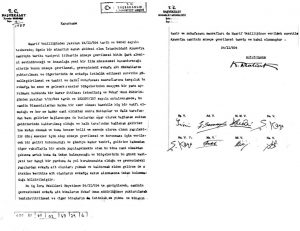
The official 1934 decree[12]
The first argument also seems controversial since there is no proof that the Council of State did not examine the legal draft before it turns into a legal decision. Moreover, there is an official decree published by Turkish State in 1934 with the signature of Mustafa Kemal Atatürk, Turkey’s then-President of the Republic. Although there are claims about the authenticity of Atatürk’s signature, since in 1934 President Atatürk was in full health, sane, and in charge of all executive affaires, I do not think there is a problem about legality of the earlier decision concerning the lawmaking technique.
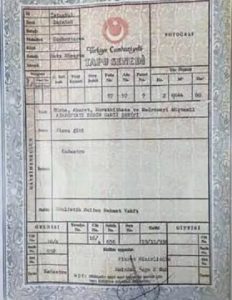
Hagia Sophia’s official record in the Turkish registry of deeds in 1936[13]
The most vindicating argument of the plaintiff is about the record of the registry of deeds and the court also approved this argument. 1936 record in the Turkish registry of deeds prove that Hagia Sophia was registered as a mosque, not as a museum. In that sense, the registry of deeds record paved way for the change in the status of Hagia Sophia by making 1934 decree null and void.
Political Analysis
Although Hagia Sophia controversy or Hagia Sophia case is primarily of a legal and technical matter, due to its political content and strong symbolism, a political science-based analysis is absolutely needed.
The first thing to be said, for sure, is about the symbolism and political message given to the world. I think President Erdoğan’s immediate decision to change the status of Hagia Sophia from museum to mosque carries important political messages. These messages concentrate on Turkey’s absolute sovereignty on its own soil, the strong presence of Islam as part of Turkish identity and Turkey’s political system (although Turkey continues to struggle for staying as a secular state), and Turkey’s increasing search for independence and multi-dimensionalism in its foreign policy. It is a fact that although Turkey has some political and economic problems, the country has boosted its self-confidence and has begun to make more unilateral steps in recent years. This is primarily caused by the reconciliation of pious masses with the state due to strong leadership of Turkish President Recep Tayyip Erdoğan, who is known as a devout Muslim and a political leader coming from a radical Islamist background. Poor Islamist masses and people coming from political Islam tradition for long decades were kept out of Turkey’s state institutions due to fears of radical Islam taking the control of the secular state and decreasing individual liberties. However, as Turkey’s population and economic problems increased, at one point it became impossible for the state to keep the status quo. In that sense, the peripheral elements (Islamists especially and Kurds in the early Erdoğan period) of the Republic became central political actors and the state was redesigned in accordance with this new sociological reality. The other option was unsustainable since a military coup like that of Egypt in 2013 was proven to be impossible in Turkey multiple times such as the February 28 process in 1997, the e-memorandum crisis in 2007, and the most recent failed coup attempt on July 15, 2016. So, President Erdoğan became the symbol of Turkey’s Islamist transformation and established his cult leadership in the eyes of pious masses. Thus, Hagia Sophia move represents in fact the continuity in Erdoğan’s political career in terms of doing things that were not done before by earlier Prime Ministers and Presidents. Erdoğan did similar bold moves in the past as well such as by resisting to military intervention attempts, defying the United States and Israel in the public (one minute crisis at World Economic Forum in Davos in 2009), conducting peace talks with the PKK, and openly criticizing Turkey’s founder Mustafa Kemal Atatürk etc.
The second important thing is about President Erdoğan’s success in following global political trends. While Erdoğan was once -in a world dominated by political leaders such as Barack Obama who represented change and promised peace to American people- ordering negotiations with the imprisoned PKK leader Abdullah Öcalan and was co-charing the organization of the “Alliance of Civilizations” with the then-Spanish Prime Minister José Luis Rodríguez Zapatero, President Erdoğan now feels like the political conjuncture is different and nationalism and unilateralism are on the rise. So, Turkey’s recent political adventurism, bold military operations in Iraq, Syria, Libya, and increasing tough stance in the Eastern Mediterranean etc. show that President Erdoğan tries to unify Turkish people by creating some nationalist and Islamist causes. It is a fact that, although President Erdoğan’s decision is not against international law, being part of UNESCO World Heritage List has certain requirements which might be more difficult to realize when Hagia Sophia will be open to public. So, as an important and very successful politician who senses things earlier, President Erdoğan thinks that the zeitgeist of the era is based on nationalism, particularism, and conservatism. In that sense, President Erdoğan is following the steps of other right-wing populist leaders such as Donald Trump (cancelling JCPOA deal, Paris Climate Accord, TTIP and TPP agreements and most recently withdrawing the U.S. from World Health Organization-WHO) and Benjamin Netanyahu (annexing Golan Heights, making plans for annexing West Bank), who are also making unilateral steps.
Thirdly, the Hagia Sophia move represents the dangerous escalation between Turkey and its Western allies in recent years due to many political disagreements. Unfortunately, Turkey has few allies left in the Western world including the United States. Moreover, it is not easy to solve problems between Ankara and Washington (U.S.) and Ankara and Brussels (European Union/EU). While Turkey has severe disagreements with Washington in Syria (about the status and future of Syrian Kurds) and in the Middle East in general (relations with Israel, Iran policy etc.), Turkey’s close relations with Russia also creates problems. Similarly, Turkey’s already frozen EU membership process was recently overshadowed by rising Turkish-Greek tensions in the Aegean and the Mediterranean and Turkish-French hustles in Libya and the Eastern Mediterranean. The rise of Islamophobia and far right movements in European countries are also problematic developments in terms of Turkish accession to EU and Turkey’s relations with European powers. Thus, with the Hagia Sophia move, President Erdoğan wants to show Western powers that they have to give some concessions to Ankara to keep within the right track and to sustain alliance based relationship.
Fourthly, President Erdoğan as a politician who tries to survive (read as getting reelected in politics), has to make some critical steps in domestic politics to keep his popularity and support. The emergence of two new right-wing parties in Turkey; former Prime Minister and Minister of Foreign Affairs Professor Ahmet Davutoğlu’s Future Party and former Minister of Economy and Minister of Foreign Affairs Ali Babacan’s Democracy and Leap (DEVA) Party are alarming signals for Erdoğan. So, as the hero of Islamist masses and a man of the people, President Erdoğan wants to reinforce his electoral support and consolidate right-wing conservative votes in the times of an economic crisis. The opening of Hagia Sophia to public prayer is a good gesture and a source of pride and joy for an average Islamist in Turkey, which would certainly increase the support of Erdoğan. It should not be forgotten that Erdoğan has always supported religious freedoms; he made the wearing of headscarf (türban) in public institutions and while making state (public) duties legal, removed the limitations against graduates of Prayer and Preacher Schools (İmam Hatip Okulları) in university exams, and restored many churches in Turkey.[14]
Possible Consequences
The political consequences of the Hagia Sophia controversy are still unclear. It will certainly negatively affect Turkey’s relations with the Western world (the United States[15], the EU[16], Pope Francis[17] and World Council of Churches also criticized[18] Erdoğan’s decision) and UNESCO[19], but I do not think it will create a direct political consequence. Rather, the image of Turkey as a country getting away from the Western world and secularism will be more widespread among decision-makers and also ordinary people. This might negatively affect Turkish economy as well; primarily the tourism and finance industries. Hagia Sophia controversy could also create a distance between Turkey and the Orthodox world including Russia, Turkey’s both friend and enemy (frenemy) due to strong cooperation in economy, but political competition in Syria, Libya, Nagorno Karabakh etc. It would not be wrong to claim that President Erdoğan’s decision could create sympathy among Muslim nations; but due to lack of democratic regimes in the Islamic world (with the exception of Tunisia), this might not turn into immediate political and economic gains for Ankara.
Conclusion
To sum up, Hagia Sophia controversy will make pious Muslims happy in Turkey for being able to pray in a historical place and also visit the place for free, but it will not help Turkey to develop better relations with the international community and especially the Christian world. It might also help President Erdoğan to keep his popularity among conservative segments; but I think the economic and political governance of the country will still be more important for average Turkish voters in the next Presidential election. So, this decision is a political move that has symbolic significance rather than severe actual political consequences.
Lastly, as an academic in favor of civilizational peace, I might suggest President Erdoğan and Turkish Directorate of Religious Affairs to make a special arrangement for this sanctuary; allowing Christians as well for Sunday prayers in order to give a peaceful message to the world. This will make Turkey a stronger country and will help Turkish government to show that they are in favor of religious freedoms, not religious hostilities.
Some cartoons depicting the changing status of the Hagia Sophia;
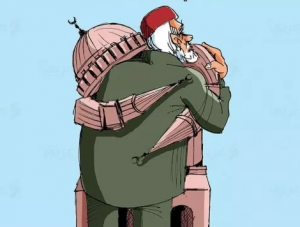
Source: https://i12.haber7.net//haber/haber7/photos/2020/28/musluman_cografyada_ayasofya_coskusu_filistinli_karikaturistten_anlamli_mesaj_1594428459_3192.jpg, Date of Accession: 14.07.2020
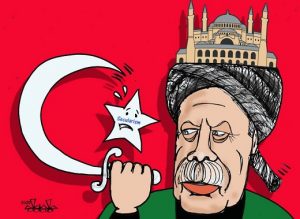
Source: https://cartoonmovement.com/_flysystem/s3/styles/product_detail_image/s3/AYA%20%20SFIA.jpg?itok=mx4dZI7f, Date of Accession: 14.07.2020
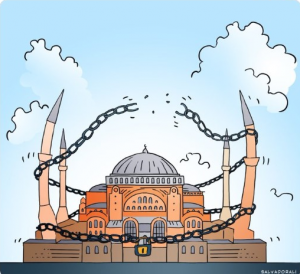
Source: https://cdn.yeniakit.com.tr/images/album/ayasofya-camii-karari-islam-dunyasini-sevince-bogdu-filistinli-karikaturistten-carpici-karikatur-afcdf5.jpg, Date of Accession: 14.07.2020
Assoc. Prof. Dr. Ozan ÖRMECİ
[1] For information about the historic building, see; https://muze.gen.tr/muze-detay/ayasofya; https://www.bbc.com/turkce/haberler/2016/03/160318_vert_tra_ayasofya; and https://en.wikipedia.org/wiki/Hagia_Sophia.
[2] Isil Sariyuce & Emma Reynolds (2020), “Turkey’s Erdogan orders the conversion of Hagia Sophia back into a mosque”, CNN, 10 July 2020, Date of Accession: 14.07.2020 from https://edition.cnn.com/2020/07/10/europe/hagia-sophia-mosque-turkey-intl/index.html.
[3] https://www.youtube.com/watch?v=e5vXQPWLvP4.
[4] Anne-Bénédicte Hoffner & Mélinée Le Priol (2020), “Sainte-Sophie, le rêve ottoman d’Erdogan”, La Croix, 2 July 2020, Date of Accession: 14.07.2020 from https://www.la-croix.com/Monde/Moyen-Orient/Sainte-Sophie-reve-ottoman-dErdogan-2020-07-02-1201103106.
[5] CNNTürk (2016), “Ayasofya önünde sabah namazı”, 28 May 2016, Date of Accession: 14.07.2020 from https://www.cnnturk.com/turkiye/ayasofya-onunde-sabah-namazi?page=1.
[6] Sabah (2016), “Ayasofya’da 80 yıl sonra ilk cuma namazı kılındı”, 21 October 2020, Date of Accession: 14.07.2020 from https://www.sabah.com.tr/video/turkiye/ayasofyada-80-yil-sonra-ilk-cuma-namazi-kilindi.
[7] The full transcript of the court decision can be read from here; http://bianet.org/bianet/diger/227263-danistay-in-ayasofya-kararinin-tam-metni.
[8] Article 52 of the 1924 constitution states that the Council of State (Şûrayı Devlet or Danıştay with modern Turkish) has to examine the law draft before it turns into an act. See; “1924 Anayasası”, Türkiye Cumhuriyeti Anayasa Mahkemesi, Date of Accession: 14.07.2020 from https://www.anayasa.gov.tr/tr/mevzuat/onceki-anayasalar/1924-anayasasi/.
[9] Kenan Kıran (2020), “Ayasofya tapuda da cami”, Sabah, 11 July 2020, Date of Accession: 14.07.2020 from https://www.sabah.com.tr/gundem/2020/07/11/ayasofya-tapuda-da-cami.
[10] The list can be seen from here; https://whc.unesco.org/en/statesparties/tr.
[11] The official page can be seen from here; https://whc.unesco.org/en/list/356.
[12] Murat Bardakçı (2018), “Ayasofya Kararnamesi’nin altındaki “K. Atatürk” imzası gerçek mi?”, Habertürk, 14 September 2018, Date of Accession: 14.07.2020 from https://www.haberturk.com/yazarlar/murat-bardakci/2141029-ayasofya-kararnamesinin-altindaki-k-ataturk-imzasi-gercek-mi.
[13] Haber7.com (2020), “İşte Ayasofya’nın Tapusu!”, 11 June 2020, Date of Accession: 14.07.2020 from https://www.haber7.com/foto-galeri/63249-iste-ayasofyanin-tapusu.
[14] The most famous example is the Bulgarian St. Stephen Church or the Bulgarian Iron Church in Balat, Istanbul.
[15] Ekathimerini.com (2020), “US State Dep’t ‘disappointed’ in Turkish government decision on Hagia Sophia”, 10 July 2020, Date of Accession: 14.07.2020 from https://www.ekathimerini.com/254628/article/ekathimerini/news/us-state-dept-disappointed-in-turkish-government-decision-on-hagia-sophia.
[16] Jonathan Stearns (2020), “EU Urges Turkey to ‘Reverse’ Hagia Sophia Reconversion Plan”, Bloomberg, Date of Accession: 14.07.2020 from https://www.bloomberg.com/news/articles/2020-07-13/eu-urges-turkey-to-reverse-hagia-sophia-reconversion-plan.
[17] AlJazeera (2020), “Pope ‘deeply pained’ over Turkey’s move on Hagia Sophia”, 12 July 2020, Date of Accession: 14.07.2020 from https://www.aljazeera.com/news/2020/07/pope-deeply-pained-turkey-move-hagia-sophia-200712151548612.html.
[18] BBC (2020), “Hagia Sophia: World Council of Churches appeals to Turkey on mosque decision”, 11 July 2020, Date of Accession: 14.07.2020 from https://www.bbc.com/news/world-europe-53375739.
[19] SBS News (2020), “UNESCO ‘deeply regrets’ Turkey’s conversion of Hagia Sophia into mosque”, 11 July 2020, Date of Accession: 14.07.2020 from https://www.sbs.com.au/news/unesco-deeply-regrets-turkey-s-conversion-of-hagia-sophia-into-mosque#:~:text=The%20Hagia%20Sophia%20was%20first,%22Historic%20Areas%20of%20Istanbul.%22.


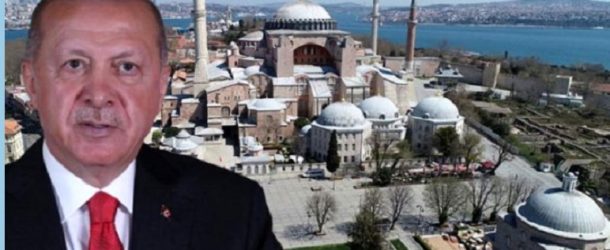

















































One Comment »